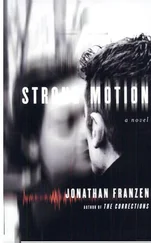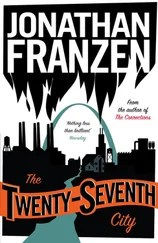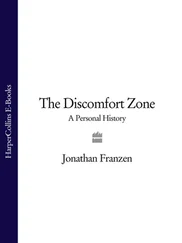Then we passed a delicious trash pile, and I pulled from it a paint-and plaster-spattered wooden chair with a broken seat and found a scrap of two-by-four to knock the bigger clumps of plaster off. It was grubby work. Jeff said: “This is what my life will be like if I write fiction?”
After years of depression, I didn’t care how forgiving of myself I sounded. I said that what mattered to me was the rescue. I could probably afford a new chair; that I prefer to live among the scavenged and reborn is my own private choice.
A sponge bath, a scrap of sturdy ash plywood from a dresser drawer abandoned at curbside, eight scavenged brass screws to attach the plywood to the underside of the seat, and a black magic marker to mask the spatters of white paint: this is how the chair was rescued.
[1996]
From Colorado Route 67, the gatehouse of the Federal Correctional Complex looks like a pavilion from an up-scale park. It has jade-colored accents and is bordered with pink gravel. As I approach it in my car, I can make out two black men in neckties behind the smoked glass windows. One of them emerges to check my ID and ask if I have weapons. I tell him I’m supposed to meet Mr. Louis Winn at one o’clock.
The guard says, “Who?”
I tell him again. With a puzzled look he returns to the pavilion, and the other man comes out. He has an ebbing hairline and a vaguely Langston Hughesish air. He’s wearing a beautiful gray pin-striped suit. “Louis Winn,” he says without a smile, shaking my hand through the open window.
“Oh, you’re Mr. Winn,” I reply with smile big enough for both of us. I’m convinced he thinks that I’m surprised because he isn’t white. He tells me to follow his car up the hill. Feeling ill-served by the guard, I dig my hole deeper by persisting: “The guard didn’t seem to know who you were.”
Mr. Winn gives me a look of withering disappointment and, without a word, proceeds to his car.
Here in Florence, Colorado, the business of American law and order is booming. The Federal Correctional Complex is the showy new product of a war on drugs which, however much or little it has curbed the nation’s illicit appetites, has helped double the federal prison population in less than a decade. The people of Florence were so keen to have its business that they bought land for the complex and presented it as a gift to the Bureau of Prisons. I’ve come to look at how the business works, inside and outside the fences.
The centerpiece of FCC Florence is the Administrative Maximum Facility, a sixty-million-dollar state-of-the-art warehouse for what the popular press likes to call the “worst of the worst” federal prisoners. ADX Florence, Alcatraz of the Rockies, and Admax are some of its aliases. John Gotti may eventually be shipped here, but Manuel Noriega won’t. (He’s a Panamanian national, and ADX’s protocols violate the Geneva Convention.) ADX currently houses about 250 prisoners — just over half its capacity — and they are locked in their cells for as many as twenty-three hours a day, deprived almost entirely of human contact. Unless capital punishment should happen to become routine, the logic and technology of American corrections are unlikely to advance any further than the systems of control at ADX.
According to Bureau of Prisons (BOP) literature, the mission of ADX “is to impact inmate behavior such that inmates who demonstrate non-dangerous behavior and participate in required programs progress to another, more open Bureau of Prisons facility.” Most of ADX’s inmates have been transferred from less secure prisons for misbehavior. Eighteen percent have murdered a fellow inmate, sixteen percent have assaulted a fellow inmate with a weapon, fifteen percent have escaped or attempted escape, and ten percent have assaulted prison staff members with a weapon. There is also a handful of inmates whom, because of their subversive political views, the Fed considers terrorists. I’ve requested interviews with two political prisoners: Mutulu Shakur and Ray Luc Levasseur.
FCC Florence has four facilities. From the gatehouse, the road winds uphill past a fenceless minimum-security prison camp (“Club Fed”), an inviting medium-security Federal Correctional Institution, a stern maximum-security penitentiary, and the triangular brick bunker that is ADX. Arid high prairie has, with federal correction, become a sprinkled, landscaped campus. When I lived in Colorado Springs, I often passed the construction site of this complex on my way to hiking trails in the Sangre de Cristos. The architecture is stripy and angular, full of teal and salmon. Until the razor wire went up I thought some real-estate cowboy was building a strangely isolated office park with energy-conserving windows.
At the check-in counter, a blond receptionist named Donna signs me in, backs me against a red brick wall, and shoots me three times with a Polaroid. All the while, she’s casually communicating with someone deep in the bowels of ADX, telling them to “bring Shakur up.” The volume and signal strength of ADX’s radios are calibrated so that voices commence speaking at conversational strength, without crackle or distortion; the speaker seems almost to be physically present. Word comes back to Donna that Shakur is being fetched. She stamps my forearm with invisible ink and holds it under a black light. The word TAMP fluoresces.
“It’s supposed to say STAMP,” Donna says, stamping me again. We check under the black light, and the second word is also TAMP. She stamps me a third time and makes a complete mess. Mr. Winn intercedes with an impatient mutter, and already I’m grateful that someone besides me has incurred his disappointment.
Although ADX is the first federal prison designed specifically for round-the-clock isolation of prisoners, the institution of solitary confinement is nearly as old as the republic. In 1823 the Commonwealth of Pennsylvania opened the Eastern State Penitentiary in Philadelphia, and what became known as the “Pennsylvania system” was copied by jail builders around the world. The Quakers who designed Eastern State believed that jails in which prisoners were housed in common rooms bred depravity, and so at Eastern State each prisoner had a cell and private exercise yard which he never left. If the prisoner had to be moved, a black hood was placed over his head to bar the ingress of free-floating depravity. That prisoners in perpetual solitary confinement often hanged themselves or battered themselves to death was attributed to insanity induced by masturbation.
Over the decades, as American jail space became more precious and penological thinking evolved, routine solitary confinement fell out of favor. By the middle of this century, court rulings had placed strict limits on the use of isolation for discipline. Beginning in the seventies, however, the idea of perpetual lockdown was resurrected as “segregation” for “administrative” purposes. Isolation as a means of controlling prisoners, rather than of punishing them, was considered “administrative” and therefore OK.
Supermaxes represent a hardening of the battle lines between society and its criminal products, and more than twenty-five states now have them. The most notorious is in California, where the confluence of a vengeful public’s know-nothingism and rising intramural gang violence led to the construction of a huge high-tech “control unit” facility at Pelican Bay, just south of the Oregon border. In January of 1995, five years after Pelican Bay opened, several aspects of its brand of punishment were deemed cruel and unusual by a federal district judge, Thelton Henderson, who said, in effect, that Californians’ wish to “lock ’em up and throw away the key” had created a nightmare. Prisoners at Pelican Bay were routinely denied access to medical and mental-health care, suffered gratuitous violence from guards, and showed signs of psychological damage — sleeplessness, inability to concentrate, suicidal thoughts, an aggravated rage against society — almost certainly caused by prolonged isolation. Because Judge Henderson did not go so far as to shut the facility down, however, state prison officials considered his ruling a victory.
Читать дальше
Конец ознакомительного отрывка
Купить книгу












